Advances in Development of Safe and Efficient Mining of Coexisting Coal and Uranium Resources
Abstract
:1. Introduction
2. Challenges Facing Coordinated Uranium–Coal Mining
2.1. Deformation of Overlying Strata Induced by Coal Seam Mining
2.1.1. Strata Deformation
2.1.2. Impact on Groundwater Environment
2.2. Disturbance of Groundwater Environment by Uranium In-Situ Leaching
2.3. Physical and Chemical Responses Trigged by Co-Mining of Uranium and Coal Deposits
- (1)
- Coal mining requires dewatering, which causes the groundwater level in uranium mining areas to continuously decline [35]. The uranium deposit is a sandstone uranium mine suitable for in-situ leaching. Mining must maintain a certain pressure head. If coal mine dewatering causes the groundwater level to exceed the lower levels suitable for in situ leaching, it will destroy the mining conditions of the Nalinggou uranium mine, resulting in unusable dead ore or rendering the uranium mine unusable.
- (2)
- Mining activities in lower coal mines may result in the spillage of uranium-containing leachates, posing the risk of radioactive contamination. During the mining activities of the lower coal mine, the formation of three zones causes changes in the groundwater seepage field, causing radionuclides to diffuse with the groundwater to the environment outside the uranium mine, polluting the surrounding groundwater environment, and even entering the coal mining area, affecting the safe operation of the coal mine.
2.4. Application of Numerical Methods in Coal-Uranium Co-Mining
3. Coordinated Mining Technology System for the Entire Uranium and Coal Mining Lifecycle
4. Key Scientific Issues in Coordinated Uranium and Coal Mining
- (1)
- The evolutionary characteristics and mechanisms of multiple phases and fields involved in uranium–coal mining process. Coal mining involves phenomena such as stress disturbances, surface subsidence, rock fractures, increases in underground fissures, and changes in groundwater seepage [30]. In addition, the underground leaching process of uranium ore involves a chemical reaction between the leaching solution and the ore-bearing layer, diffusion of various chemical substances, and migration of the leaching solution. Clarifying the changing rules of the rock stress, fissure, and groundwater seepage fields in coal mining and the evolution characteristics and rules of the chemical, diffusion, and solute transport fields involved in uranium mining are key to constructing a multiphase uranium–coal mining process.
- (2)
- Accurate characterization of multiphase and multifield cross-scale, full-time spatiotemporal coupling in coordinated uranium–coal mining areas. During the entire period of coordinated mining of uranium and coal, on the basis of the study of cross-scale spatial evolution rules and integration of time characteristics, we aim to establish a cross-scale multifield, including a cross-scale and full-time regional stress field, fracture field seepage field, geochemical field, and multiphase (including gas–liquid–solid) coupling model, to accurately characterize regional crack development rules, hydrodynamic field evolution, radionuclide migration and diffusion rules, and solute concentration change characteristics throughout the life of uranium–coal coordinated mining.
5. Key Technologies for Coordinated Uranium and Coal Mining
5.1. Technology to See through the Geological Characteristics of Uranium and Coal Deposits
5.2. Safe and Efficient Mining of Uranium Coal and Interference Reduction Technology
5.3. Uranium–Coal Coordinated Mining Isolation Technology
5.4. “Trinity” Pollution Prevention and Control Technology
5.5. Establishment of Intelligent Early Warning and Decision-Making Platform
6. Overlook into Conclusions
- (1)
- Based on the spatial superposition rules and superposition types of co-associated uranium coal, through the uranium coal mining process characteristics, mechanisms, control mechanisms, and geological process response rules and evolution characteristics, a coordinated mining model of avoidance, distance, and interference reduction throughout the lifecycle is constructed to form uranium planning methodology for safe, efficient and green mining of coal resources.
- (2)
- Our studies focused on constructing an adaptation mechanism for co-associated uranium coal coordinated mining, establishing a coupling evolution mechanism of the stress field, seepage field, chemical field, and solute transport process under the disturbance conditions of coordinated uranium coal mining, and revealing the strata deformation and contaminant leaching of coordinated uranium coal mining. The liquid migration law provides a theoretical model and important theoretical support for the coordinated and efficient development of uranium and coal resources, thus forming a theoretical system for coordinated uranium and coal mining.
- (3)
- Based on the co-associated uranium–coal coordinated mining technology system, joint studies on key technologies such as safe and efficient uranium–coal mining technology, uranium–coal coordinated mining isolation technology, and “trinity” pollution prevention and control technology are performed through a combination of industry, academia, research, and application. These points lead to areas, and areas lead to bodies that form a technical methodology for coordinated uranium and coal mining.
- (4)
- On the basis of obtaining planning, theoretical, and technical methodologies for coordinated uranium and coal mining, we will focus on co-associated uranium and coal in the Ordos Basin, conduct demonstration applications and promotions, and establish engineering practices for coordinated uranium and coal mining.
Author Contributions
Funding
Conflicts of Interest
References
- Fu, Y.; Wei, S.; Jin, R.; Li, J.; Ao, C. Research status and existing problems of zoning characteristics of sandstone type uranium deposits in China. Acta Geol. Sin. 2016, 90, 3519–3544. [Google Scholar] [CrossRef]
- Yuan, L.; Zhang, T.; Zhao, Y.X.; Ren, B.; Hao, X.J.; Xu, C. Precise coordinated mining of coal and associated resources: A case of environmental coordinated mining of coaland associated rare metal in Ordos basin. J. China Univ. Min. Technol. 2017, 46, 449–459. [Google Scholar] [CrossRef]
- Ren, D.; Dai, S. Potential associated mineral resources in coal and coal bearing rock series—A problem worthy of attention. China Coal Geol. 2009, 10, 1–4. [Google Scholar] [CrossRef]
- Chen, J.; Chen, P.; Yao, D.; Huang, W.; Tang, S.; Wang, K.; Liu, W.; Hu, Y.; Zhang, B.; Sha, J. Abundance, distribution, and modes of occurrence of uranium in Chinese coals. Minerals 2017, 7, 239. [Google Scholar] [CrossRef]
- Qin, P.; Meng, Z.; Li, Y.; Zhao, C.; Jiao, W.; Sun, Y. Foreign multi energy coexistence of minerals in the same basin Preliminary study on enrichment law. J. Hebei Inst. Archit. Technol. 2005, 22, 76–78. [Google Scholar] [CrossRef]
- He, L. Resultant compilation Comparative analysis of uranium bearing properties of cover rocks in Russian platforms. World J. Nucl. Geosci. 2004, 21, 193–198. [Google Scholar] [CrossRef]
- Dai, S.; Yang, J.; Ward, C.R.; Hower, J.C.; Liu, H.; Garrison, T.M.; French, D.; O’Keefe, J.M. Geochemical and mineral evidence for a coal-hosted uranium deposit in the Yili basin, Xinjiang, northern China. Ore Geol. Rev. 2015, 70, 1–30. [Google Scholar] [CrossRef]
- Yang, B.; Luo, J.; Dai, Y.; Liu, X.; Lin, T.; Zhang, S. The relationship between uranium and organic matter, oil and gas and coal in uranium bearing sandstone: Ten red beaches in the basin area as an example. J. Northwest Univ. Nat. Sci. Ed. 2006, 6, 982–987. [Google Scholar] [CrossRef]
- Yang, R.; Han, Z.; Liu, Y.; Fan, A. Relationship between Jurassic coal and uranium deposits in Dongsheng area, Ordos Basin. J. Geosci. Environ. 2006, 28, 31–37. [Google Scholar] [CrossRef]
- Li, Y.; Qin, M.; He, Z. Temporal and spatial distribution of uranium, oil and coal and uranium mineralization in Erlian Basin, Inner Mongolia. World Nucl. Geosci. 2009, 1, 25–30. [Google Scholar] [CrossRef]
- Zhang, S.; Wang, S.; Yin, J. Lincang, Yunnan Regional Bangmai Basin Uranium-bearing Germanium in coal Research. Uranium Geol. 1987, 5, 267–275. [Google Scholar]
- Yuan, L. Scientific problems and Countermeasures of precise mining of coal and associated resources. J. Coal 2019, 44, 1–9. [Google Scholar]
- Huang, B.; Zhao, X.; Yu, B.; He, G.; Yue, Z.; Yang, C.; Wang, C.; Meng, Q.; Yang, Y.; Liu, J.; et al. Theory and technical conception of coordinated mining of coal and associated strategic metal minerals. Acta Coal Sin. 2022, 47, 2516–2533. [Google Scholar]
- Yavuz, H. An estimation method for cover pressure re-establishment distance and pressure distribution in the goaf of longwall coal mines. Int. J. Rock Mech. Min. Sci. Géoméch. Abstr. 2004, 41, 193–205. [Google Scholar] [CrossRef]
- Zhu, P.; Chen, J.; Yu, X.; Xu, Q.; Liu, W. Sandstone type uranium deposit In situ leaching of uranium Overview of process methods. Min. Technol. 2011, 11, 4–6. [Google Scholar] [CrossRef]
- Wang, H.; Tan, Y.; Du, Y.; Su, X. In Situ Leaching Uranium Well Site Technology; Metallurgical Industry Press: Beijing, China, 2002. [Google Scholar]
- Lian, G.; Li, M.; Tang, Q.; Sun, J.; Cao, F.; He, Z.; Bai, X. Somewhere Immersion Well pad pumping is greater than Note proportion Study on the relationship between groundwater and environmental impact. Uranium Min. Metall. 2017, 36, 144–150. [Google Scholar] [CrossRef]
- Atkins, M.L.; Santos, I.R.; Perkins, A.; Maher, D.T. Dissolved radon and uranium in groundwater in a potential coal seam gas development region (Richmond river catchment, Australia). J. Environ. Radioact. 2016, 154, 83–92. [Google Scholar] [CrossRef]
- Burow, K.R.; Belitz, K.; Dubrovsky, N.M.; Jurgens, B.C. Large decadal-scale changes in uranium and bicarbonate in groundwater of the irrigated western U.S. Sci. Total. Environ. 2017, 586, 87–95. [Google Scholar] [CrossRef]
- Zhang, T.; Nie, X.; Song, S.; Hao, X.; Yang, X. Modeling uranium transport in rough-walled fractures with stress-dependent non-darcy fluid flow. Mathematics 2022, 10, 702. [Google Scholar] [CrossRef]
- Zhang, H.; Zhang, T.; He, Y. Reactive transport model of uranium by CO2 + O2 in situ leaching. Environ. Sci. Pollut. Res. 2023, 30, 65976–65989. [Google Scholar] [CrossRef]
- Zhang, T.; Zhang, H.; Yang, X.; Mao, J.; Su, X.; Liu, Y.; Zhou, G.; Xie, Z. Alkaline in-situ leaching of uranium in low-permeability sandstone: An experimental study using online low field nuclear magnetic resonance (LF-NMR) spectroscopy on multiphase response. Hydrometallurgy 2024, 225, 106269. [Google Scholar] [CrossRef]
- Zhang, T.; He, X.; Zhang, K.; Wang, X.; Liu, Y. Hydrogeology response to the coordinated mining of coal and uranium: A transparent physical experiment. Geofluids 2021, 2021, 6236455. [Google Scholar] [CrossRef]
- Cui, G.; Wei, J.; Feng, X.-T.; Liu, J.; Elsworth, D.; Chen, T.; Xiong, W. Preliminary study on the feasibility of co-exploitation of coal and uranium. Int. J. Rock Mech. Min. Sci. Géoméch. Abstr. 2019, 123, 104098. [Google Scholar] [CrossRef]
- Wang, L.; Vuik, C.; Hajibeygi, H. A stabilized mixed-fe scheme for frictional contact and shear failure analyses in deformable fractured media. Eng. Fract. Mech. 2022, 267, 108427. [Google Scholar] [CrossRef]
- Rakesh, K.; Kumar, S.A.; Kumar, M.A.; Rajendra, S. Underground mining of thick coal seams. Int. J. Min. Sci. Technol. 2015, 6, 25–36. [Google Scholar]
- Liang, Y. Scientific conception of precise coal mining. J. Coal 2017, 42, 1–7. [Google Scholar] [CrossRef]
- Guo, W.; Ma, Z.; Bai, E. Current status and prospect of coal mining technology under buildings, water bodies and railways, and above confined water in China. Coal Sci. Technol. 2020, 47, 16–26. [Google Scholar]
- Gläser, D.; Helmig, R.; Flemisch, B.; Class, H. A discrete fracture model for two-phase flow in fractured porous media. Adv. Water Resour. 2017, 110, 335–348. [Google Scholar] [CrossRef]
- Xu, H.; Tang, D.; Mathews, J.P.; Zhao, J.; Li, B.; Tao, S.; Li, S. Evaluation of coal macrolithotypes distribution by geophysical logging data in the hancheng block, eastern margin, Ordos basin, China. Int. J. Coal Geol. 2016, 165, 265–277. [Google Scholar] [CrossRef]
- Zhu, Q.; Yu, R.; Feng, X.; Li, J.; Sima, X.; Tang, C.; Xu, Z.; Liu, X.; Si, Q.; Li, G.; et al. Mineralogy, geochemistry, and fluid action process of uranium deposits in the Zhiluo formation, Ordos basin, China. Ore Geol. Rev. 2019, 111, 102984. [Google Scholar] [CrossRef]
- Akhtar, S.; Yang, X.; Pirajno, F. Sandstone type uranium deposits in the Ordos basin, Northwest China: A case study and an overview. J. Asian Earth Sci. 2017, 146, 367–382. [Google Scholar] [CrossRef]
- Zhang, T.; Yuan, L.; Wei, Z.; Liu, Y. Coupled multifield response to coordinate mining of coal and uranium: A case study. Water 2019, 12, 139. [Google Scholar] [CrossRef]
- Zhu, W.C.; Wei, C.H. Numerical simulation on mining-induced water inrushes related to geologic structures using a damage-based hydromechanical model. Environ. Earth Sci. 2011, 62, 43–54. [Google Scholar] [CrossRef]
- Yang, W.; Lin, B.-Q.; Qu, Y.-A.; Li, Z.-W.; Zhai, C.; Jia, L.-L.; Zhao, W.-Q. Stress evolution with time and space during mining of a coal seam. Int. J. Rock Mech. Min. Sci. Géoméch. Abstr. 2011, 48, 1145–1152. [Google Scholar] [CrossRef]
- Zhang, T.; Gan, Q.; Zhao, Y.; Zhu, G.; Nie, X.; Yang, K.; Li, J. Investigations into Mining-Induced Stress–Fracture–Seepage Field Coupling Effect Considering the Response of Key Stratum and Composite Aquifer. Rock Mech. Rock Eng. 2019, 52, 4017–4031. [Google Scholar] [CrossRef]
- Zhang, T.; Yuan, L.; Yang, K.; Liu, Y.; Wei, F.; Yu, X. Modeling of multiphysical–chemical coupling for coordinated mining of coal and uranium in a complex hydrogeological environment. Nat. Resour. Res. 2020, 30, 571–589. [Google Scholar] [CrossRef]
- Li, E.; Li, J.; Yu, Y.; Zeng, J.; Miao, H.; Liu, K. Discussion on water environment problems induced by coal mining in Jining City. Met. Mines 2013, 5, 139–143. [Google Scholar] [CrossRef]
- Allow, K.A. The use of injection wells and a subsurface barrier in the prevention of seawater intrusion: A modelling approach. Arab. J. Geosci. 2011, 5, 1151–1161. [Google Scholar] [CrossRef]
- Sampath, K.; Perera, M.; Elsworth, D.; Matthai, S.; Ranjith, P.; Dong-Yin, L. Discrete fracture matrix modelling of fully-coupled CO2 flow—Deformation processes in fractured coal. Int. J. Rock Mech. Min. Sci. Géoméch. Abstr. 2021, 138, 104644. [Google Scholar] [CrossRef]
- Zhang, S.; Liu, J.; Wei, M.; Elsworth, D. Coal permeability maps under the influence of multiple coupled processes. Int. J. Coal Geol. 2018, 187, 71–82. [Google Scholar] [CrossRef]
- Lin, P.; Werner, J.; Ali, Z.A.; Bertucci, L.; Groppo, J. Kinetics and Modeling of Counter-Current Leaching of Waste Random-Access MemoryChips in a Cu-NH3-SO4 System Utilizing Cu(II) as an Oxidizer. Materials 2023, 16, 6274. [Google Scholar] [CrossRef]
- Van Lien, T.; Dinh, T.T.; Dung, N.T.K. Study on leaching systems and recovery for PALUA–PARONG low grade uranium sandstone ores. Hydrometallurgy 2020, 191, 105164. [Google Scholar] [CrossRef]
- Liang, Y.; Chen, J.; Chen, L. Mechanism and application of hydraulic curtain in water injection wells to prevent seawater intrusion. J. Yangtze River Acad. Sci. 2009, 26, 133–136. [Google Scholar] [CrossRef]
- Jemcov, I. Impact assessment of grout curtain on the hydraulic behavior in karst, based on time a series analysis. Environ. Earth Sci. 2019, 78, 1–17. [Google Scholar] [CrossRef]
- Yan, T.; Wang, W.; Chen, L.; Wang, Z.; Ren, Y. Hydrological effects of the underground hydraulic curtain with different design parameters based on numerical modeling for a co-exploitation of coal and uranium. Int. J. Coal Geol. 2022, 257, 104011. [Google Scholar] [CrossRef]
- Lu, P.; Hou, K. Application status and development trend of curtain grouting technology in mine water control. Mod. Min. 2010, 3, 21–24. [Google Scholar] [CrossRef]
- Shi, R.; Yue, F.; Zhang, Y.; Lu, L. The temperature distribution along a freezing pipe wall during liquid nitrogen freezing. J. China Univ. Min. Technol. 2013, 42, 12–18. [Google Scholar]
- Wen, J. Ground controlled by freezing technology: Leaching uranium extraction: The feasibility analysis on control of drawing and injecting liquid flow rate by the technology of freezing in-situ leaching uranium. Uranium Min. Metall. 2017, 36, 84–87. [Google Scholar] [CrossRef]
- Baborowski, M.; Bozau, E. Impact of former mining activities on the uranium distribution in the River Saale (Germany). Appl. Geochem. 2006, 21, 1073–1082. [Google Scholar] [CrossRef]
- Bister, S.; Birkhan, J.; Lüllau, T.; Bunka, M.; Solle, A.; Stieghorst, C.; Riebe, B.; Michel, R.; Walther, C. Impact of former uranium mining activities on the floodplains of the Mulde River, Saxony, Germany. J. Environ. Radioact. 2015, 144, 21–31. [Google Scholar] [CrossRef]
- Li, M.; Lian, G.; Cao, F.; Yang, B. Non-uniform sampling Injection technology in-situ leaching Application of groundwater environmental protection. Uranium Min. Metall. 2017, 36 (Suppl. S1), 98–104. [Google Scholar] [CrossRef]
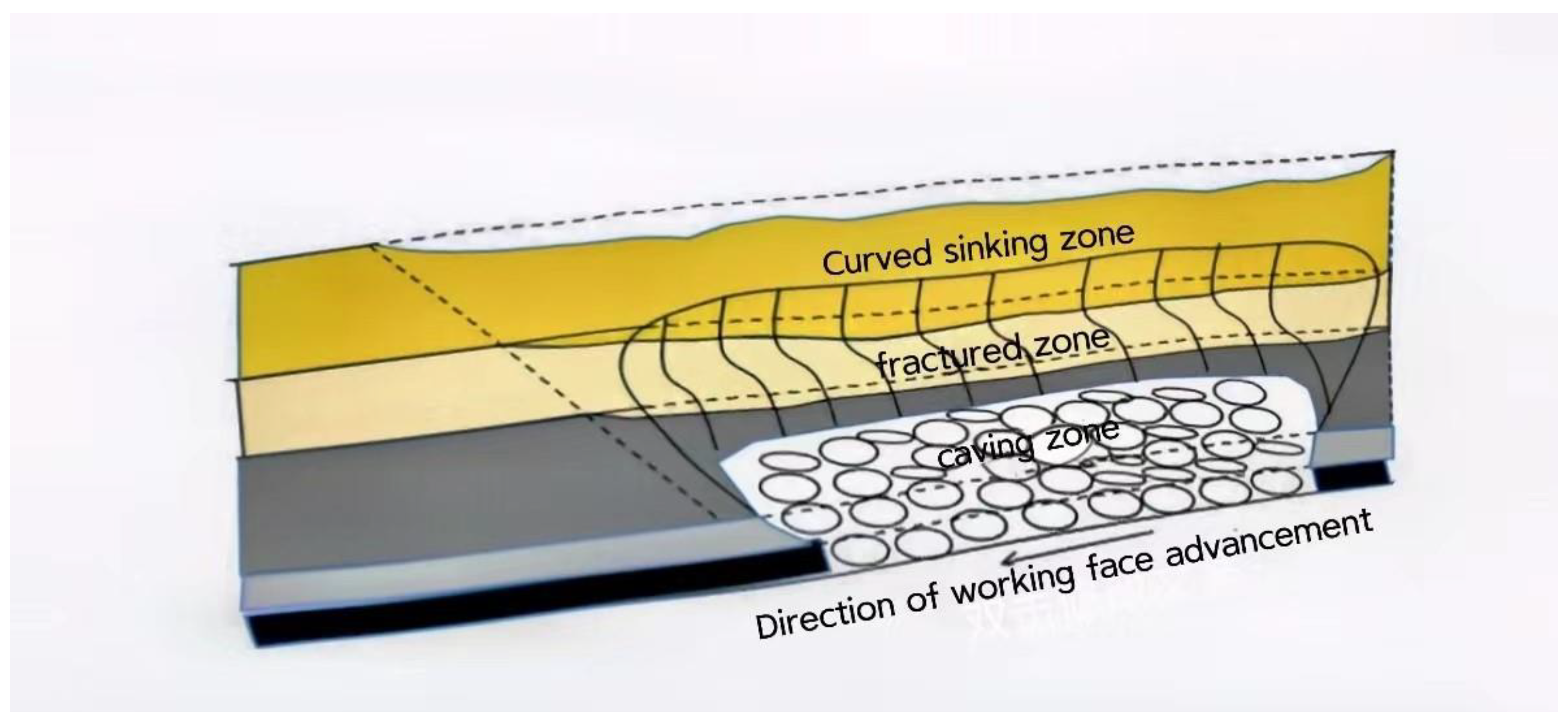
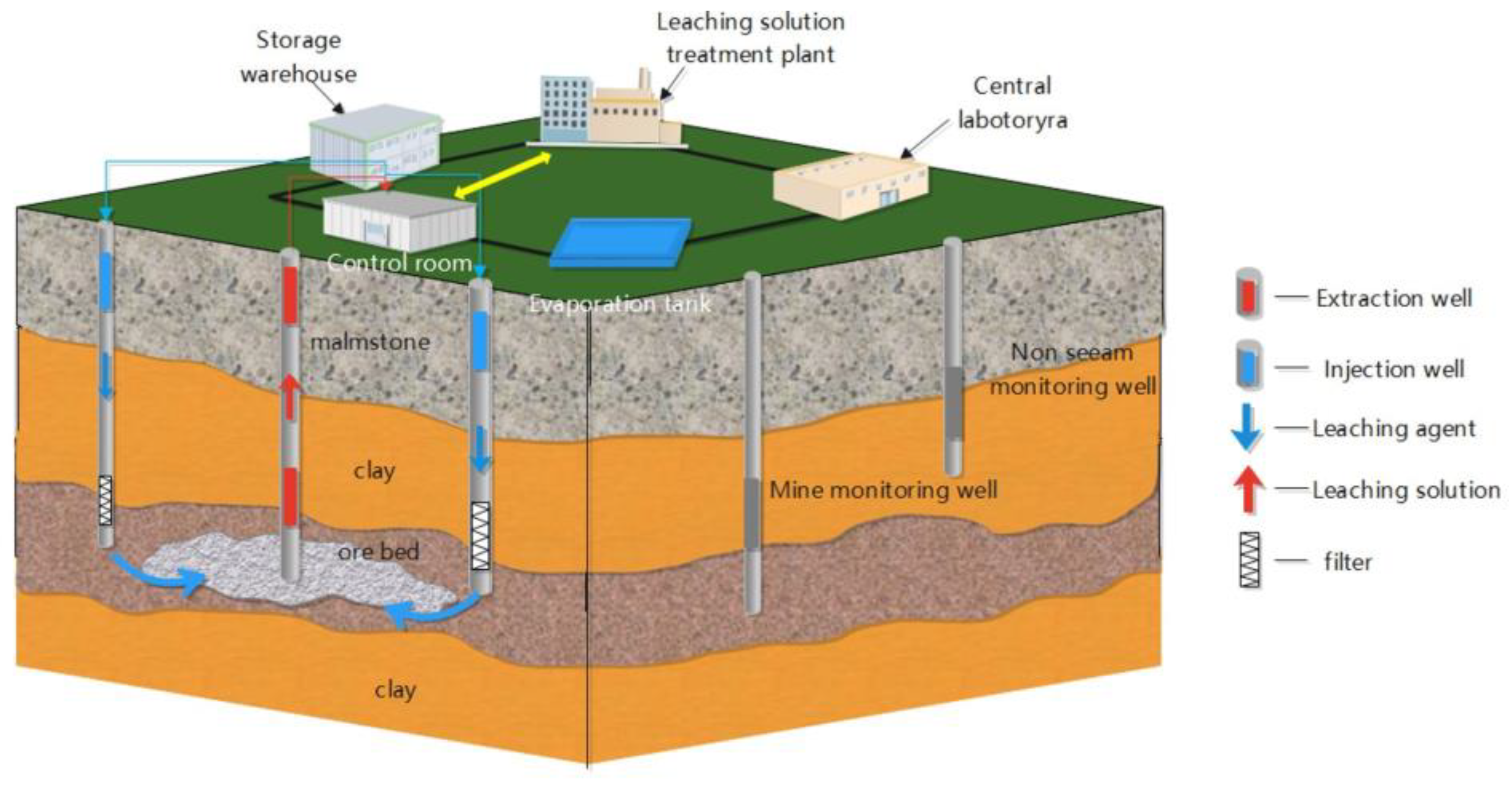


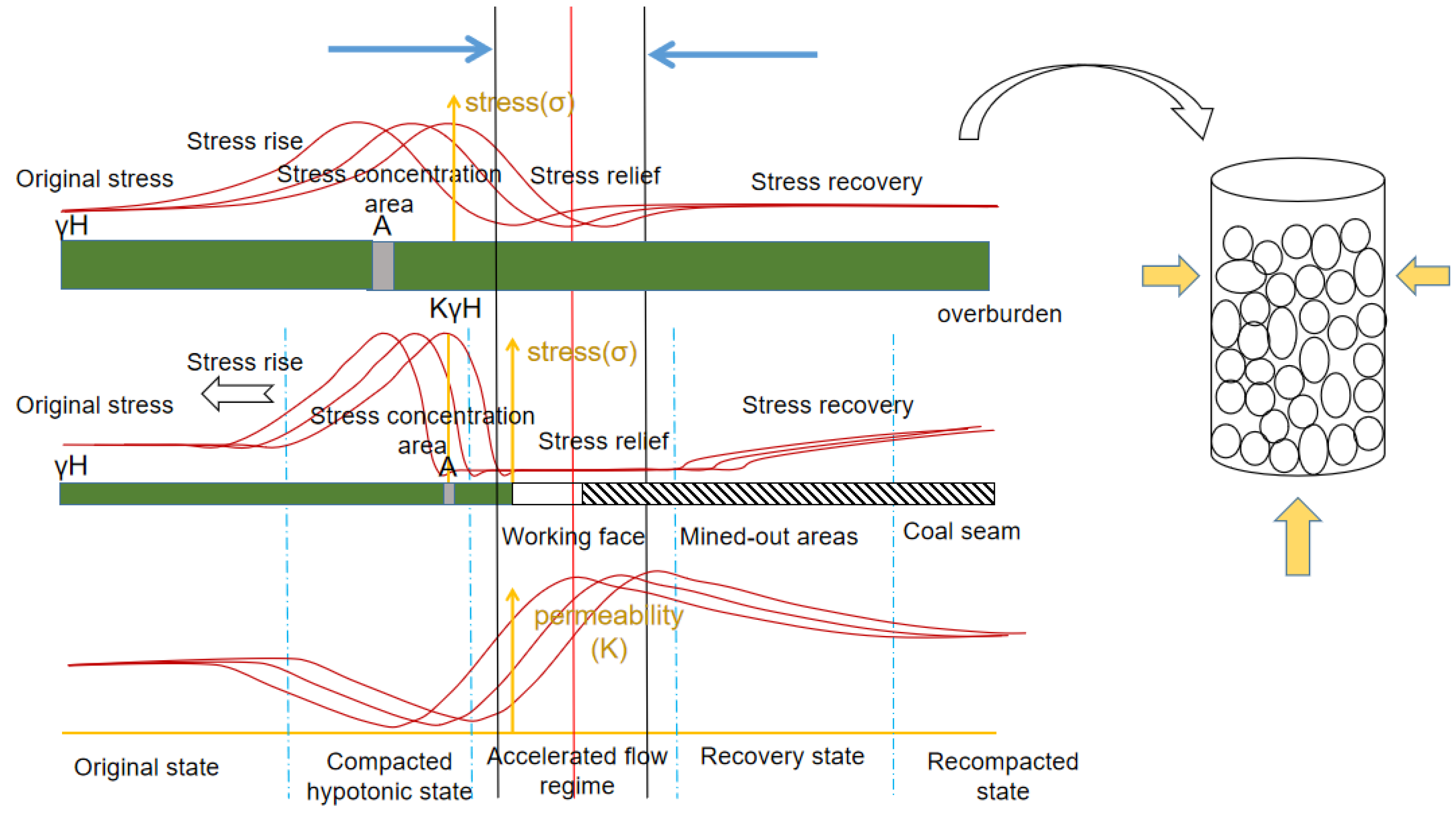
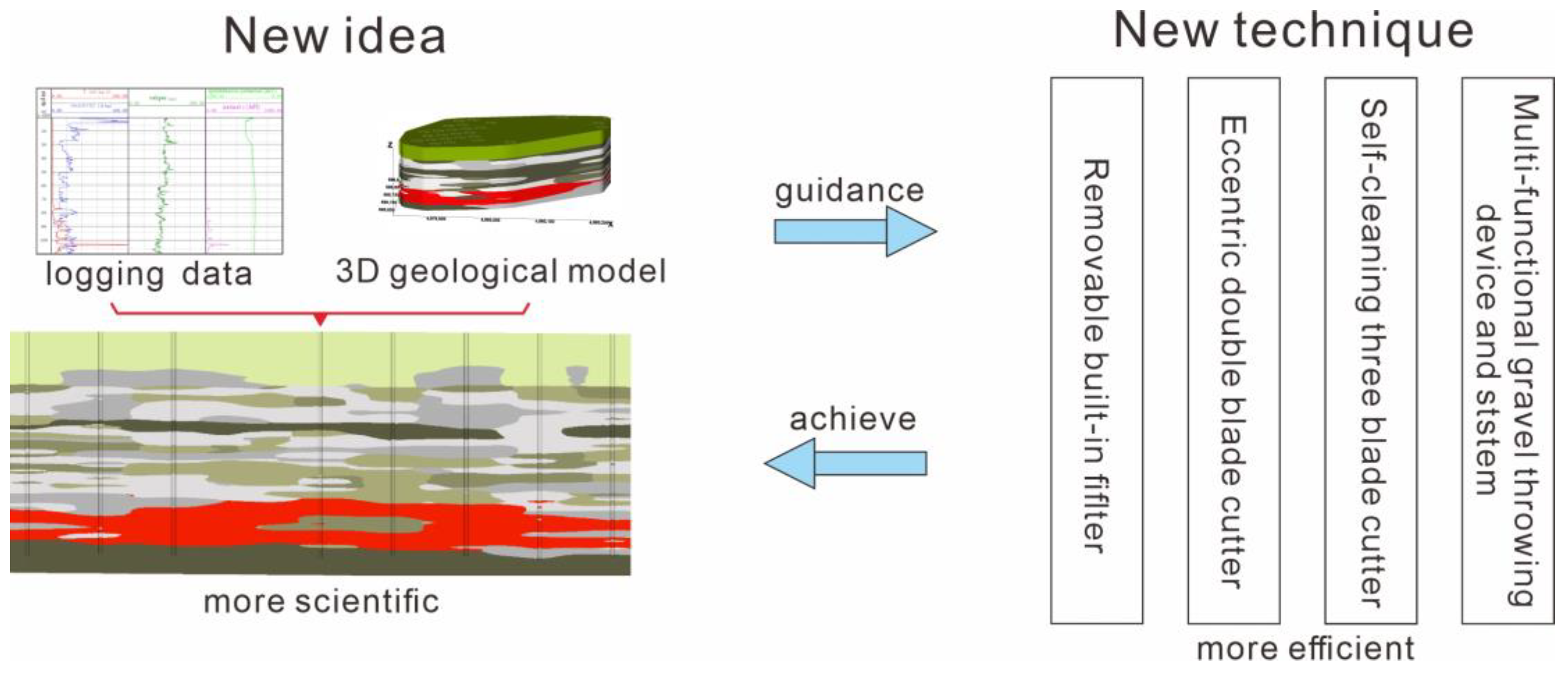
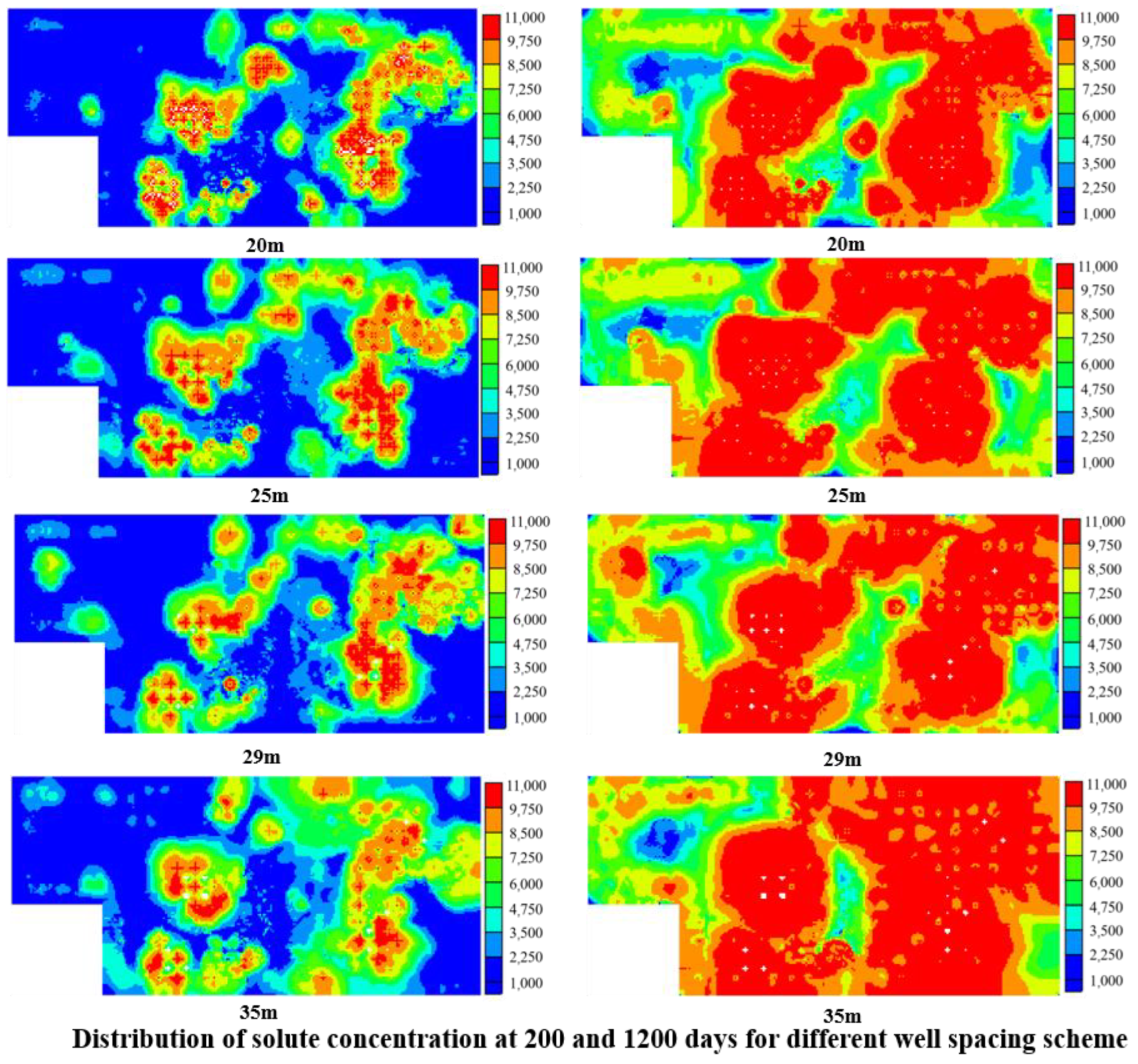
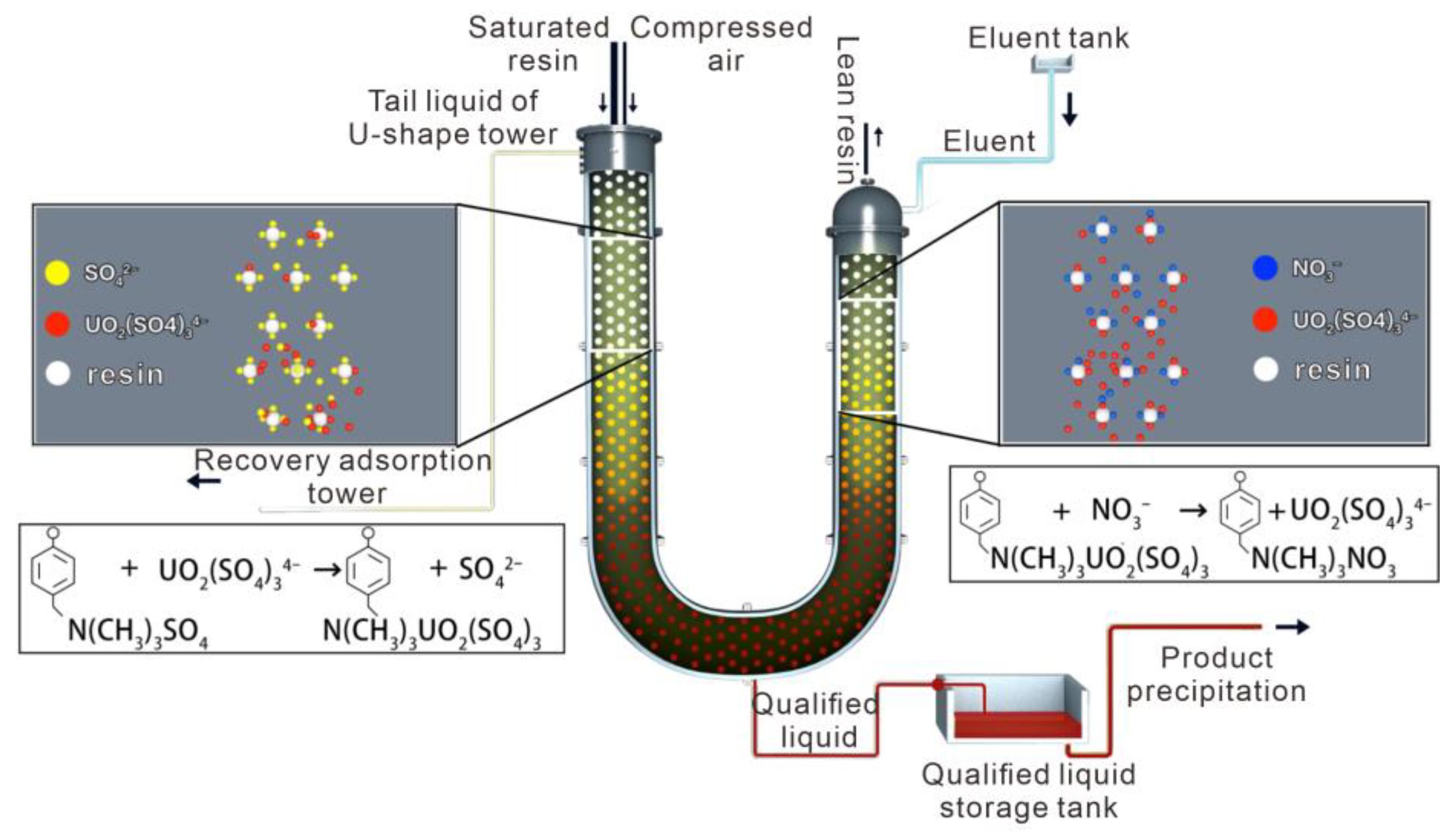
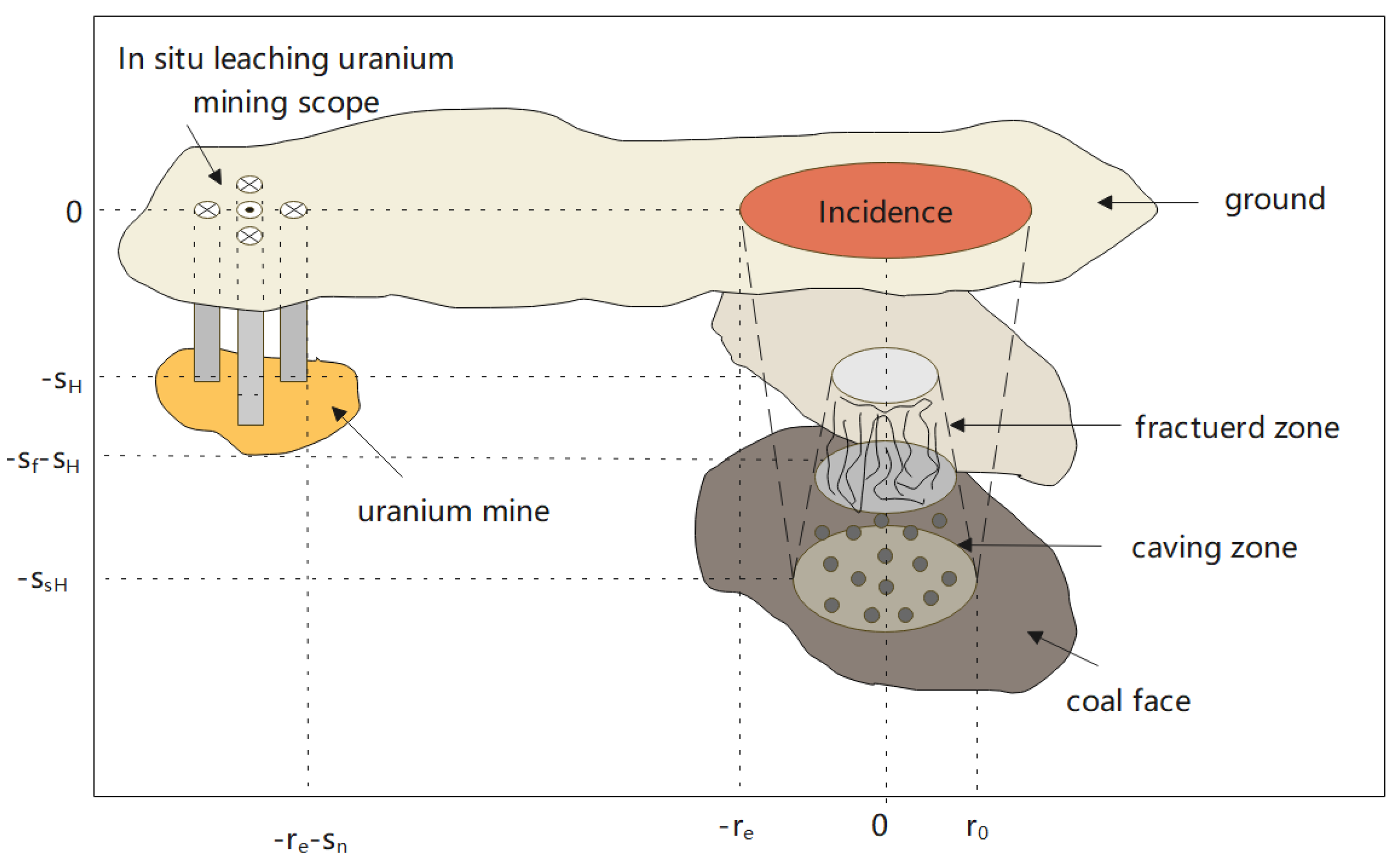
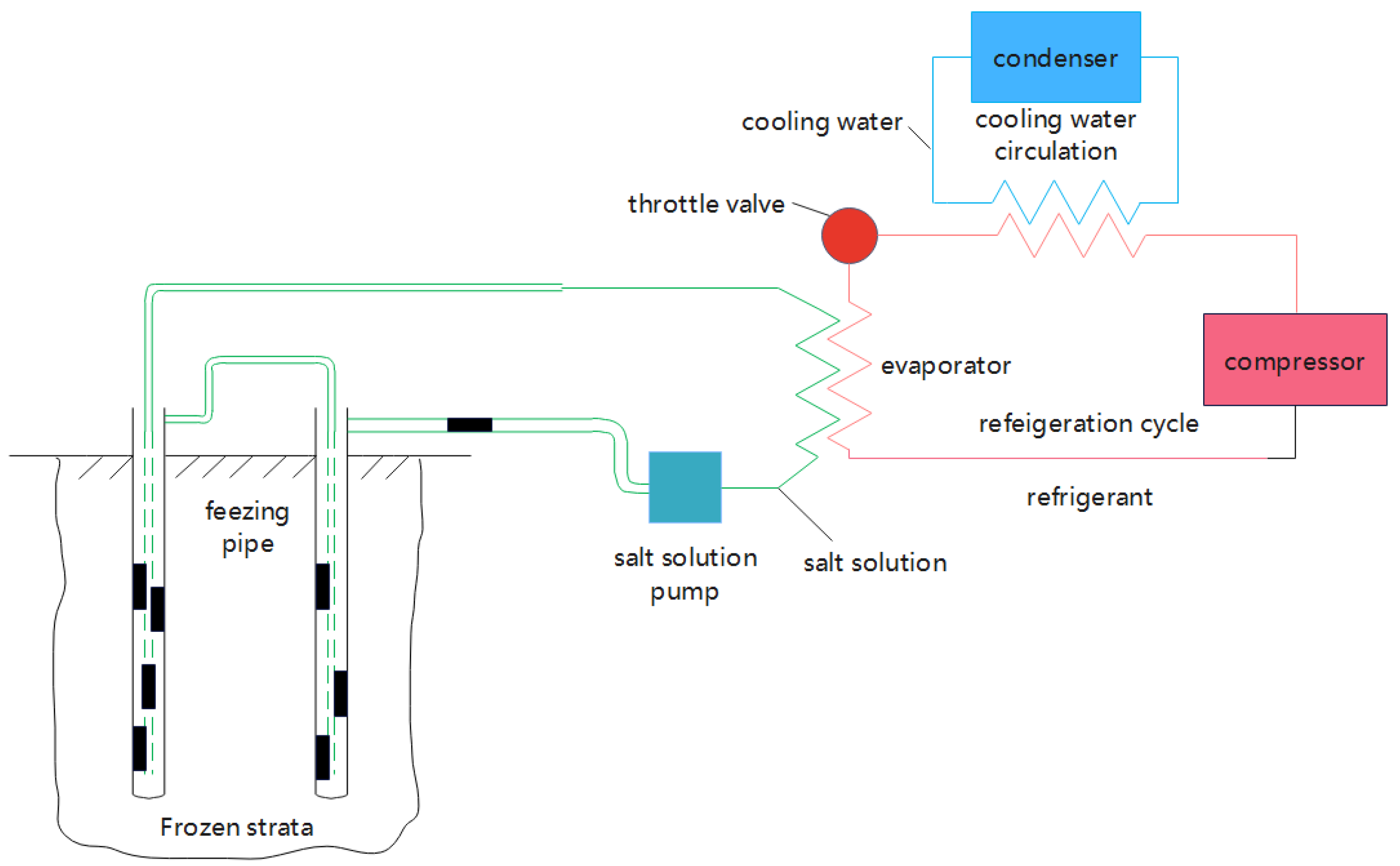
Disclaimer/Publisher’s Note: The statements, opinions and data contained in all publications are solely those of the individual author(s) and contributor(s) and not of MDPI and/or the editor(s). MDPI and/or the editor(s) disclaim responsibility for any injury to people or property resulting from any ideas, methods, instructions or products referred to in the content. |
© 2024 by the authors. Licensee MDPI, Basel, Switzerland. This article is an open access article distributed under the terms and conditions of the Creative Commons Attribution (CC BY) license (https://creativecommons.org/licenses/by/4.0/).
Share and Cite
Su, X.; Liu, X.; Du, Z.; Hou, C.; Li, M.; Cao, F.; Chen, M.; Zhang, T. Advances in Development of Safe and Efficient Mining of Coexisting Coal and Uranium Resources. Processes 2024, 12, 1340. https://doi.org/10.3390/pr12071340
Su X, Liu X, Du Z, Hou C, Li M, Cao F, Chen M, Zhang T. Advances in Development of Safe and Efficient Mining of Coexisting Coal and Uranium Resources. Processes. 2024; 12(7):1340. https://doi.org/10.3390/pr12071340
Chicago/Turabian StyleSu, Xuebin, Xiaochao Liu, Zhiming Du, Chunru Hou, Mengjiao Li, Fengbo Cao, Meifang Chen, and Tong Zhang. 2024. "Advances in Development of Safe and Efficient Mining of Coexisting Coal and Uranium Resources" Processes 12, no. 7: 1340. https://doi.org/10.3390/pr12071340



